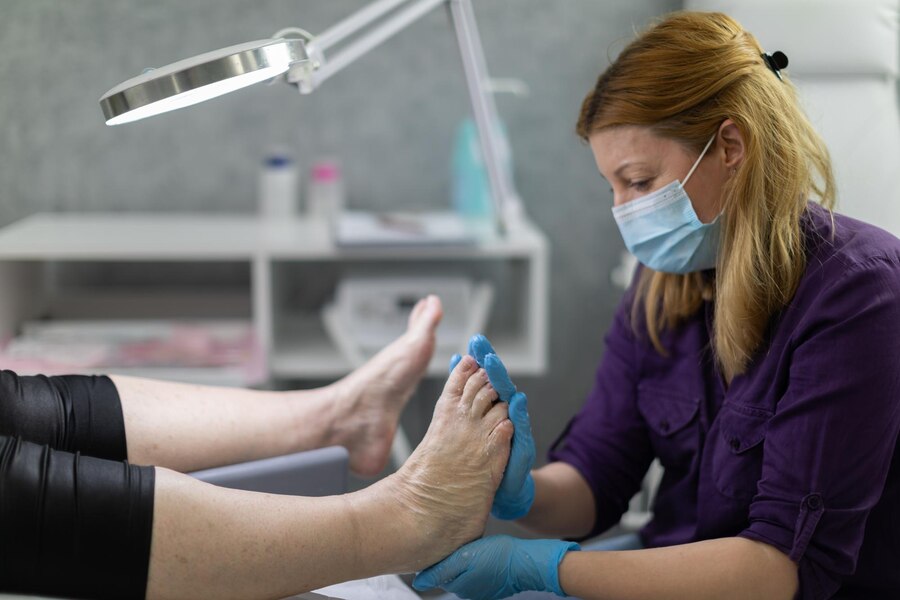Foot and ankle problems can significantly impact daily life, causing pain, discomfort, and limiting mobility. Podiatrists, also known as chiropodists, are the experts in diagnosing and treating these conditions. They possess the specialized knowledge and skills to assess, diagnose, and treat a wide range of foot and ankle disorders, ensuring optimal foot health and well-being.

Understanding Podiatry and Chiropody Treatment
What Is Chiropody Treatment?
Chiropody is a specialized field of podiatry that focuses on diagnosing and treating foot-related ailments. It includes preventive care, pain management, and corrective treatment for conditions such as corns, calluses, ingrown toenails, and diabetic foot complications.
Why Is Chiropody Important?
Chiropody plays a crucial role in maintaining overall foot health. Since our feet bear the body’s weight daily, they are prone to various issues that can affect mobility, comfort, and overall well-being. Regular visits to a podiatrist can help prevent foot complications and ensure proper foot function.
Common Foot Conditions Treated by a Podiatrist
- Corns and Calluses
Corns and calluses form due to excessive pressure or friction on the skin. They can cause pain and discomfort, affecting daily activities. A podiatrist can safely remove them and provide guidance on preventive measures.
- Ingrown Toenails
Ingrown toenails occur when the nail grows into the surrounding skin, leading to pain and infection. A podiatrist can provide treatment, including trimming the nail properly or performing minor surgical procedures if necessary.
- Fungal and Bacterial Infections
Conditions such as athlete’s foot and fungal toenails are common foot infections that require proper medical treatment. A podiatrist can prescribe antifungal medications and recommend hygiene practices to prevent recurrence.
- Heel Pain and Plantar Fasciitis
Plantar fasciitis is a common cause of heel pain due to inflammation of the plantar fascia. A podiatrist may recommend orthotics, stretching exercises, and physical therapy to alleviate discomfort and prevent further damage.
- Diabetic Foot Care
People with diabetes are prone to nerve damage (neuropathy) and poor circulation, leading to foot ulcers and infections. Regular visits to a podiatrist ensure early detection and management, preventing severe complications such as amputation.
How a Podiatrist Performs Chiropody Treatment
- Initial Foot Examination
A podiatrist will start with a thorough examination of your feet, assessing skin, nails, circulation, and overall foot structure. This helps diagnose potential issues and create a personalized treatment plan.
- Nail and Skin Care
Podiatrists perform professional nail trimming and treatment of fungal infections. They also address hard skin removal, corns, and cracked heels, ensuring proper foot hygiene and comfort.
- Orthotic and Footwear Recommendations
In many cases, foot problems arise due to improper footwear or misalignment. A podiatrist may suggest custom orthotics (shoe inserts) to support the feet, relieve pain, and prevent further complications.
- Minor Surgical Procedures
For conditions such as ingrown toenails or persistent corns, a podiatrist may perform minor surgical procedures under local anesthesia. These treatments provide long-term relief and prevent infection risks.
- Preventive Foot Care Advice
A podiatrist educates patients on how to maintain healthy feet through proper hygiene, footwear choices, and exercises. This helps prevent the recurrence of foot problems and improves overall foot health.
When Should You See a Podiatrist?
Signs You Need Chiropody Treatment
- Persistent foot pain or swelling.
- Corns, calluses, or cracked heels causing discomfort.
- Ingrown toenails or nail infections.
- Diabetic foot concerns such as numbness or slow-healing wounds.
- Difficulty walking due to arch or heel pain.
How Often Should You Visit a Podiatrist?
For general foot health, it is recommended to visit a podiatrist at least once a year. However, individuals with diabetes, arthritis, or chronic foot pain may require more frequent visits.
FAQs
1. What is the difference between a podiatrist and a chiropodist?
Both terms refer to foot health specialists, though “podiatrist” is more commonly used today. They provide chiropody treatment, foot assessments, and corrective care.
2. Does chiropody treatment hurt?
Most chiropody treatments are non-invasive and painless. Procedures like corn removal and nail trimming are performed gently to ensure comfort.
3. Is chiropody treatment covered by insurance?
Many health insurance plans cover podiatry and chiropody services, especially for conditions like diabetes-related foot care. Check with your provider for details.
4. How can I prevent foot problems between chiropody visits?
Maintain good foot hygiene, wear supportive shoes, use moisturizing creams, and perform daily foot exercises to keep your feet healthy.
5. Can a podiatrist help with foot pain caused by flat feet?
Yes, podiatrists offer custom orthotics, exercises, and footwear recommendations to support individuals with flat feet and alleviate pain.
Conclusion
Chiropody treatment by a podiatrist is essential for preventing, diagnosing, and treating foot ailments. Whether you suffer from minor issues like calluses or severe complications such as diabetic foot ulcers, professional care ensures long-term foot health and mobility.
Taking proactive steps toward foot care by consulting a podiatrist regularly will help prevent complications, relieve pain, and maintain an active lifestyle.
Book an appointment with our podiatrist today for expert chiropody treatment! (469) 496-2456 or visit us https://texasspecialtyclinic.com/
